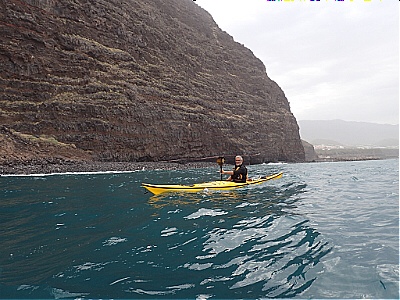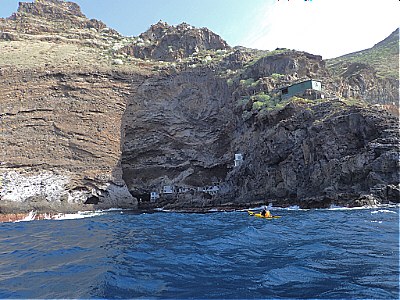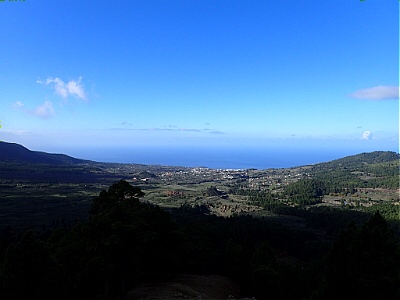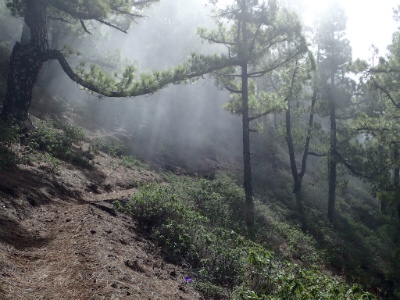La Palma

Caramor - sailing around the world
Franco Ferrero / Kath Mcnulty
Wed 24 Dec 2014 22:05
Franco with Marina de Tazacorte in the background
Half way up on the left is a well varnished canoe-stern Irish boat from Donegal. Brendan and his Breton wife Marina are permanent residents of the marina. They arrived here many years ago having retraced the Brendan Voyage and feel no urge to go any further. Brendan dressed his boat overall (hoisted all the signal flags into the rigging) to celebrate Marina's birthday, a nice touch which Marina did not appreciate.
Ian and Julie aboard Morven, one of the few British boats we have seen, have an interesting tale to tell. They left England eight years ago for a two year cruise in the Mediterranean. They arrived in Ithaka, Greece and a couple of weeks later, Ian went off one morning to buy bread. He came back two hours later with a loaf as well as the keys to a small cottage in need of renovation he had bought on the way to the bakery (a witnessed handshake with the owner was enough to secure the deal). They settled in the cottage and learnt Greek while spending the summers cruising. Last autumn, as usual they had the boat taken out of the water for the winter. She was propped up in the shipyard and they were living on board for a few days before returning to the cottage in Ithaka. One night a freak weather event resulted in a tornado sweeping through the yard; every boat on the tarmac came crashing down while yachts in the water were laid flat - some were found to have keel paint at the top of their masts! The devastation was absolute and several people were badly hurt. Morven's mast was broken and her keel needed patching but luckily for Julie and Ian she was well insured and they were able to repair her to a very good standard. They have decided to make the most of Morven's renewed condition and have set sail once again, they will possibly, like us, make their way down to Patagonia and beyond.
Franco bumped into Christine and Jean-Michel of Kan-er-Mor outside the toilet block, they had been our neighbours in Santa Cruz de Tenerife and had arrived a few days before us, they were on the other pontoon. We have met up with them a few times to share meals and Christine cooked us Breton crepes on our final night in Tazacorte. They built Kan-er-Mor themselves thirty years ago and have sailed every summer with their children, now they are retired and are cruising slowly, possibly around the world. Jean-Michel comes across as a confident and considered sailor. We spoke to him about out gas alarm problems, he doesn't have one, he went on to describe how he checked for a gas leak using a blowtorch! When we installed our new gas system, the manual for one of the fittings explicitly said "do not use a flame to check for leaks" we had laughed at the time, who would be that stupid ... Christine has burnt their house down twice so we now have them down as dangerous pyromaniacs!
We fancied going kayaking and I had toyed with the idea of kayaking round La Palma until we examined a detailed map - three ports and nowhere else to pull in. Instead we paddled up the coast for a bit but the coastline isn't very interesting, one long uniform cliff with absolutely no beaches and a strong swell on most days. We went a little further than Bahia de Piratas, a remarkable settlement, the original island dwellers lived here but now the houses are holiday homes.
Franco paddling north from Puerto de Tazacorte
Franco exiting Cueva Bonita
Bahia de Piratas - a remarkable settlement in the cliffs
La Palma is at ease with itself, everybody we spoke to loves living here. The lifestyle is relaxed and there is true community. Tourism is low-key and integrated into real towns and villages unlike in the south of Gran Canaria. The beauty of the island lies inland with its spectacular volcanoes and steep gorges. We dialled a taxi and headed for Pino de la Virgen ... or so we thought. Mario, our driver, a Colombian married to a La Palman he met while working in London was chatty and funny. We arrived: "El Pilar" he said. "Ah but we wanted to go to Pino de la Virgen, not El Pilar". He turned to Franco: "I wouldn't have brought you to El Pilar, only she said El Pilar". "Oh no I didn't", thought I, instantly feeling much less fond of Mario!
Luckily it wasn't too far to El Pino de la Virgen and we were soon walking up a very steep hill. The height gain was 1000m over two kilometres but the walking was relatively easy on an old mule track, the original road which connects the interior of La Palma to the two ports of Santa Cruz on the east and Puerto de Tazacorte on the West. It climbs to the spine of the island from where we continued up the ridge to the caldera of an ancient volcano.
View towards Tazacorte (west) on the way up
View towards Santa Cruz, the capital (east) from the ridge
Our plan was to spend two or three days walking the rim of the Caldera de Taburiente which would eventually take us down to the mirador de Time, only a few kilometres above the Puerto de Tazacorte. The timings given on the map were for 7 hours coming down the way we were going up so we expected it to take us longer, then 4 hours for the higher peaks above 2000m and finally 7 hours for the descent to El Time.
Kath walking up the spine which divides the island
Canary pine draped in lichen
From Punto de los Roques (2049m) looking across the Caldera towards El Roque de los Muchachos
Franco admiring El Teide on Tenerife sticking up above the clouds 70 miles away
As it was we did well and reached the summit of Pico de Nieve (2230m) after five and a half hours, we continued for a couple of hours until we found a good bivouac spot at the top of Pico de la Cruz (2351m), out of the freezing wind and from where we would be able to enjoy the sun until it set shortly after 6pm.
We had made a fundamental mistake in our planning; the map shows natural springs and the route description suggests one can find water all year round, as a result we had only carried three litres between us. We never found the springs, they were probably frozen, so by the evening our water was running low and we had the whole of the next day to go. We had passed bushes with hoarfrost so we collected icicles in our drink bottles to melt them at night in our sleeping bags.
Franco collecting ice
Our bivouac at the Pico de Santa Cruz
We quickly dived into our bivvy and sleeping bags as the temperature plummeted and ate dinner in bed. We hadn't brought a stove to save weight so the menu was cold but tasty couscous salad followed by caramel flan, washed down with ice cold water. We snuggled down with our bottles full of ice and enjoyed the night's entertainment: a meteor shower. La Palma is world-renowned for its ideal conditions for astronomical observation and just a mile from our bivouac is one of the largest complexes in Europe of telescopes and observatories.
The observatories on the horizon, taken from our bivouac
We slept well though intermittently probably because we were in bed for so long (nearly 12 hours of darkness). Each time I woke my feet felt heavier, this puzzled me but didn't concern me enough to investigate. At 7:30 I finally stuck my head out of the bivvy bag to find that I was covered in a sheet of ice! Franco, to my surprise wasn't, he is a walking furnace, that guy! We got up and dressed quickly in the sunshine, downed the obligatory muesli and set off. The mist was rising from the valleys and pouring from one side of the col to the other, unfortunately our path went straight through it, cold and wet and the ground was still icy under foot. It was a relief to start climbing the other side into the sunshine and out of the wind.
Looking back, the icy mist hasn't lifted yet
The next natural spring on the map was located near the main observatory but when we reached it there was no sign of running water. We decided to knock on the observatory door and beg for water, no one came though we could hear voices inside. We carried on and spotted a building with an open door and a yellow car parked outside, inside we met a man in black overalls who had no water but very kindly offered to go back to his office to get some for us. He returned with two large bottles. He is from London and was delighted to meet fellow Brits (he had assumed we were German as most visitors are). He works for the Newton Group and came to La Palma for four years initially but has stayed twenty-eight (and counting ...). Both his children have grown up here and his son now runs a language school in Santa Cruz. He wished us a Merry Christmas as we parted. We will be toasting him with a glass of our best and only Port come the day.
The observatories
Our walk took us to the top of El Roque de los Muchachos, the highest peak of the island at 2421m where we had lunch and watched the antics of a very cheeky raven. Franco gave him crumbs but he was definitely after the cheese, and could no doubt have opened the Tupperware given half the chance. There was a tap (not noted on the map) outside the closed tourist info kiosk and we topped up our water bottles. The air was very cold but the sun was strong.
Raven after our cheese
From here it would be downhill all the way. We stopped regularly to strip off layers and to nurse our bruises as we both slipped a few times, the going was steep and rough, the views fantastic.
Franco - a few layers removed
Back into the pine trees and the mist
Terraces - a sure sign that the village isn't far
We had expected the final section, an old mule path through the villages to be easier, unfortunately since the tarmac road was laid, this path has been neglected and parts of it have washed away exposing the hard uneven lava flow base.
Vertiginous view from the Torre de Time
The Tazacorte plain from Mirador de Time
Our feet breathed a sigh of relief when we reached the Mirador de Time and found out that a guagua (bus) would be passing thirty minutes later - just time for a coffee.
Kath

























